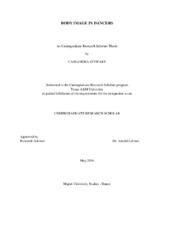| dc.description.abstract | Body Image in Dancers
Introduction
Understanding how a dancer’s self-perception can differentiate skilled dancers versus dancers not living up to her/his full potential. Knowing ways to help make an environment better for dancers can help end warped thinking in the way they perceive themselves. Obviously, it could depend on the genre and age of the dancer. Society may look at dancers a certain way, which could lead to eating disorders in response to social pressures. Three measurements were used for the purpose of this study: The NEO-PI Big Five, Social Physique Anxiety Scale, and Sports Anxiety Scale. The NEO-PI Big Five (Costa & McCrae, 1985) measures openness, conscientiousness, extraversion, neuroticism, and agreeableness; these were used to determine the personality of the subjects. The Social Physique Anxiety Scale (Hart, Leary & Rejesky, 1989) measures social anxiety related to the physique of the dancer. Additionally, the Sports Anxiety Scale (Smith, Smoll & Schutz, 1990) measures somatic trait anxiety and two cognitive trait anxieties (worry and concentration disruption), which were used to determine the anxiety level in the participants. These three measurements were used to determine if there was a correlation between dancers and their body image.
Method
The subjects of this study were fifty-seven undergraduate female dancers attending a large state university in the southwest who volunteered to participate. The participants responded to a test booklet that contained a brief coversheet where they were asked to indicate their preferred dance genre (ballet, ballroom, hip hop, jazz, modern, or tap). The dancers were also asked to respond to the NEO-PI Big Five Inventory (sixty items), the SPAS (twelve items), and the SAS (twenty-one items). SAS statistical procedures were used to analyze the resulting data.
Results
The Statistical Systems (SAS) Multiple Regression Analyses procedures were employed in order to determine the relationship between the Social Physique Anxiety Scale (SPAS), the Sport Anxiety Scale (SAS), and the Big Five Scale. The Big Five Neuroticism scale was a significant predictor of the SPAS construct (F(5,51) = 4.97, p<.009, r2=.33), the Somatic Anxiety subscale (F(5,51) = 3.90, p<.004, r2=.28), and the Worry measure (F (5,51) = 7.92, p<.0001, r2=.33). The Welch’s t test (for unequal sample sizes and unequal variances) was used to compare the participants’ Big Five scale means to T-score means (M=50, STD=10; n=774). Created from a diverse sample of college students, the dancers scored significantly higher (p<.01) than the normative sample on the Big Five Openness (M=54.0 vs. 50) and Neurotic (M=56 vs. 50) scales. No significant differences were noted between the participants and the normative sample for the Conscientiousness, Extraversion, and Agreeableness Big Five scales (the dance participants score at or very near the T-score means on these variables). | en |


